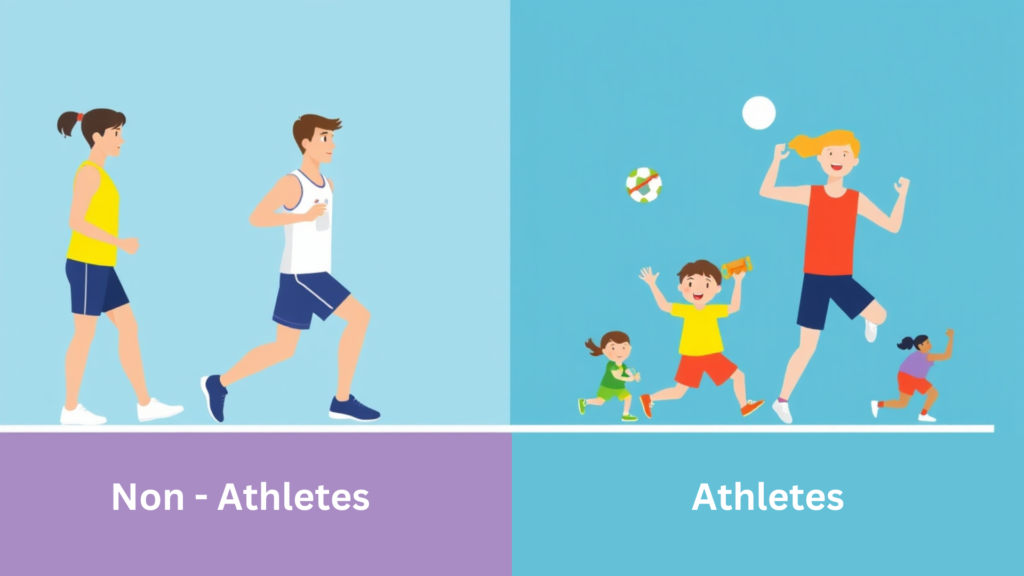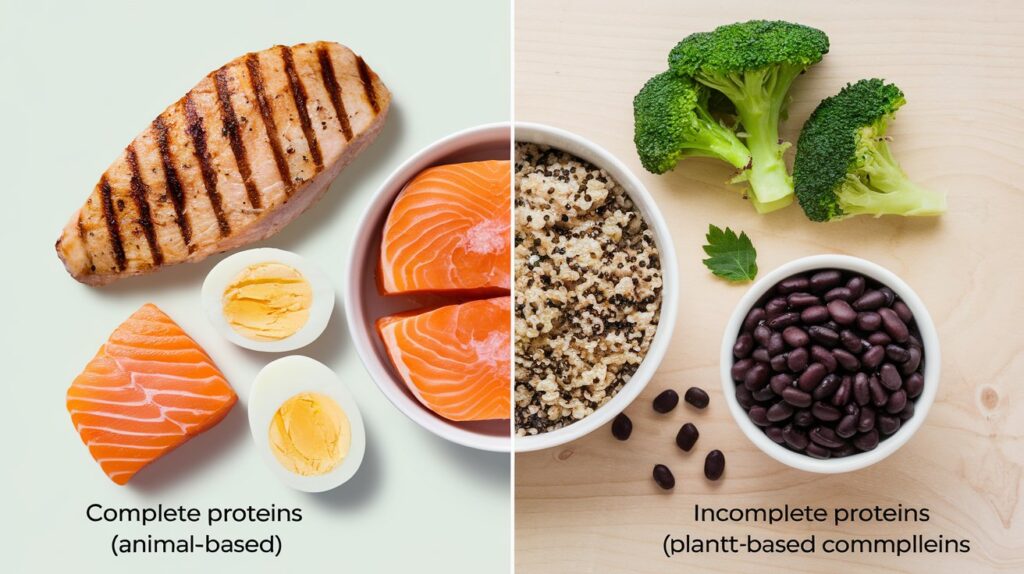The quest for the perfect protein balance can be confusing, with countless sources and recommendations that sometimes leave us more puzzled than informed.
To simplify this journey, I’ve crafted a comprehensive guide tailored to the protein needs of children, teenagers, and adults. This article is designed to answer all your questions and ensure you can confidently meet your family’s nutritional needs.

Whether you’re curious about the ideal protein sources for your little athlete or seeking the right amounts for yourself, this guide will break down everything you need to know. From understanding the optimal protein intake for various age groups to discovering the best protein-rich foods, we’ve got you covered.
Dive into this article to uncover:
- The essential daily protein requirements for growing kids, active teenagers, and adults.
- The top protein sources for each age group, from classic favorites to innovative options.
- Practical tips on incorporating these proteins into daily meals and snacks.
I’m here to help you navigate the world of protein with clarity and confidence, so you can support your family’s health and performance at every stage. Ready to discover the secrets of protein? Let’s get started!
Why Everyone Needs Protein
Protein is an essential nutrient that plays a crucial role in maintaining overall health and well-being. Here’s why it’s vital for everyone:
- Building and Repairing Tissues: Protein is a fundamental component of every cell in our body. It helps build and repair tissues, including muscles, skin, and organs. This is especially important for growth in children and recovery from injuries.
- Supporting Immune Function: Proteins are key components of the immune system. Antibodies and other immune system molecules are made of proteins, which help defend the body against infections and diseases.
- Maintaining Muscle Mass: Protein is critical for maintaining and building muscle mass. This is important not just for athletes, but for everyone, as muscle mass supports overall strength, mobility, and metabolic health.
- Producing Enzymes and Hormones: Many enzymes and hormones in the body are proteins. Enzymes facilitate biochemical reactions, while hormones regulate various bodily functions, including metabolism, growth, and mood.
- Regulating Fluid Balance: Proteins help regulate fluid balance in and out of cells and tissues. Proper protein intake helps prevent issues like edema (swelling due to fluid retention).
- Providing Energy: While not the primary source of energy, protein can be used as an energy source if carbohydrates and fats are insufficient. This is particularly important during periods of intense physical activity or when energy needs are high.
- Supporting Healthy Metabolism: Proteins play a role in maintaining a healthy metabolism by influencing various metabolic processes and promoting the efficient use of nutrients.
- Enhancing Satiety: Protein helps increase feelings of fullness and satisfaction after meals, which can aid in weight management and prevent overeating.
In summary, protein is essential for growth, repair, and maintenance of bodily functions. Ensuring adequate protein intake is crucial for overall health and well-being across all stages of life.
Protein Requirements by Age Group
Protein Needs for Infants, Toddlers, Children, and Teenagers
| Age Group | Protein Requirement (grams/day) |
|---|---|
| Infants (0-1 years) | 9-11 grams |
| Toddlers (1-3 years) | 13 grams |
| Young Children (4-8 years) | 19 grams |
| Preteens (9-13 years) | 34 grams |
| Teenagers (14-18 years) | Boys: 52 grams Girls: 46 grams |
Protein Needs for Adults
| Age Group | Protein Requirement (grams/day) |
|---|---|
| Sedentary Adults | 0.8 grams per kg of body weight |
| Active Adults | 1.2 – 2.0 grams per kg of body weight |
| Older Adults (65+ years) | 1.0 – 1.2 grams per kg of body weight |
| Pregnant/Breastfeeding Women | 1.1 – 1.5 grams per kg of body weight |
Protein Requirements for Athletes vs. Non-Athletes (Adults and Kids)

Athletes or individuals engaged in regular physical activity require more protein than sedentary individuals to repair muscle tissues, support muscle growth, and improve performance. Kids involved in sports also need more protein than their non-athlete counterparts.
Protein Needs for Active Adults vs. Sedentary Adults
| Type | Protein Requirement (grams/kg of body weight) |
|---|---|
| Sedentary Adults | 0.8 grams |
| Active Adults (Endurance) | 1.2 – 1.6 grams |
| Active Adults (Strength Training) | 1.6 – 2.0 grams |
Protein Needs for Active Kids vs. Non-Athletic Kids
| Age Group | Non-Athlete Kids (grams/day) | Kids in Sports (grams/day) |
|---|---|---|
| Young Children (4-8 years) | 19 grams | 25 – 30 grams |
| Preteens (9-13 years) | 34 grams | 45 – 50 grams |
| Teenagers (14-18 years) | Boys: 52 grams Girls: 46 grams | Boys: 70-75 grams Girls: 60-65 grams |
- Endurance sports (running, swimming, cycling) increase the need for protein to repair muscles after prolonged activity.
- Strength-based sports (weightlifting, gymnastics, combat sports) require more protein to support muscle growth and recovery.
Best Protein Sources: A Comparative Analysis

Both athletes and non-athletes benefit from a variety of protein sources. Here’s a comparison of the best protein-rich foods suitable for different age groups and activity levels.
| Food Source | Serving Size (100 grams) | Protein Content | Other Nutrients | Suitable for Ages (Years) |
|---|---|---|---|---|
| Eggs | 1 large egg (50g) | 6 grams | Vitamin B12, D | 1+ |
| Chicken Breast | 100 grams | 31 grams | Iron, Zinc | 9+ |
| Salmon (Cooked) | 100 grams | 25 grams | Omega-3s | 9+ |
| Greek Yogurt | 100 grams | 10 grams | Calcium, Probiotics | 2+ |
| Cheese (Cheddar) | 28 grams (1 oz) | 7 grams | Calcium, Vitamin D | 2+ |
| Lentils (Cooked) | 100 grams | 9 grams | Fiber, Iron | 4+ |
| Quinoa (Cooked) | 100 grams | 8 grams | Magnesium, Fiber | 4+ |
| Chickpeas (Cooked) | 100 grams | 19 grams | Fiber, Iron | 9+ |
| Tofu | 100 grams | 8 grams | Calcium, Iron | 4+ |
| Peanut Butter | 2 tbsp (32g) | 8 grams | Healthy fats | 2+ |
| Almonds | 28 grams (1 oz) | 6 grams | Vitamin E, Magnesium | 4+ |
Protein for Kids, Children, and Teenagers

Infants (0-1 Years)
Infants require 9-11 grams of protein daily. Breast milk or formula provides sufficient protein for babies up to 6 months, after which pureed protein-rich foods like soft scrambled eggs or lentils can be introduced.
Toddlers (1-3 Years)
Toddlers need around 13 grams of protein per day. Good sources include eggs, Greek yogurt, and peanut butter, as toddlers tend to have smaller appetites and need nutrient-dense snacks.
Young Children (4-8 Years)
Children aged 4-8 require 19 grams of protein daily to support steady growth and cognitive development. Foods such as cheese, lentils, tofu, and quinoa are excellent options for this age group. For kids involved in sports, their protein needs increase to around 25-30 grams daily.
Preteens (9-13 Years)
Preteens, especially those engaging in physical activities, need about 34 grams of protein per day. Chicken breast, fish, chickpeas, and dairy products like yogurt are great protein sources. Preteens involved in sports need up to 45-50 grams of protein daily to support their physical activities.
Teenagers (14-18 Years)
Teenagers require higher protein intake to support rapid growth during puberty. Boys need about 52 grams, while girls need about 46 grams of protein daily. For teenagers involved in sports, the requirement increases to 70-75 grams for boys and 60-65 grams for girls. Foods like chicken, fish, eggs, and lentils are crucial at this stage, and protein shakes can be introduced for active teens involved in sports.
Protein for Adults
Sedentary Adults
Protein needs for sedentary adults are around 0.8 grams per kilogram of body weight. For instance, an adult weighing 70 kilograms requires about 56 grams of protein daily.
Active Adults (Endurance and Strength Training)
For adults involved in regular exercise or strength training, protein requirements increase to 1.2 – 2.0 grams per kilogram of body weight. For a 70-kg active adult, this equates to 84-140 grams of protein daily, depending on the intensity of the physical activity.

Complete vs. Incomplete Proteins
- Complete Proteins: Animal-based proteins such as eggs, chicken, and fish contain all nine essential amino acids, making them complete proteins.
- Incomplete Proteins: Many plant-based proteins are incomplete, but they can be combined to form a complete protein. For instance, pairing rice with beans or lentils with quinoa will provide all essential amino acids.
Practical Tips for Meeting Protein Needs

- For Toddlers: Incorporate nutrient-dense snacks like peanut butter on toast, Greek yogurt, and scrambled eggs.
- For School-Aged Children: Pack protein-rich lunches like cheese cubes, almonds, or hummus with veggies.
- For Active Kids: Offer meals that include high-protein sources like chicken, lentils, or quinoa to meet their increased needs.
- For Teenagers: Encourage meals that include high-protein foods, and consider adding protein shakes for active teens involved in sports.
- For Adults: Balance protein intake between plant-based and animal-based sources to meet individual dietary needs while maintaining overall health.
Conclusion

Protein is essential for everyone, but protein needs vary significantly based on age, activity level, and lifestyle. Sedentary individuals need less protein compared to those engaged in sports or physical activities. Ensuring that children, teenagers, and adults consume the right amount of protein from a variety of sources—both plant-based and animal-based—can help support growth, repair tissues, and maintain overall health.
By understanding and meeting protein requirements, both athletes and non-athletes can enjoy better physical performance, muscle development, and long-term well-being.